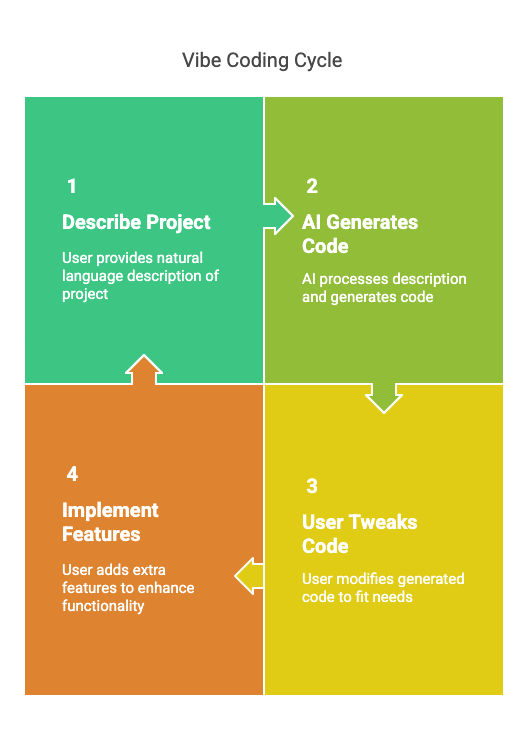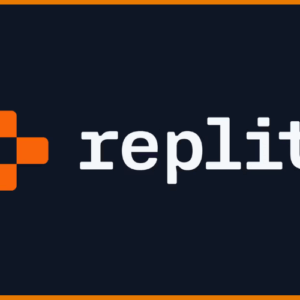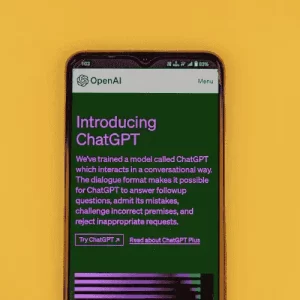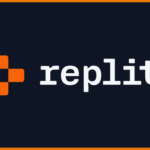Vibe Coding: In the ever-evolving world of programming, we’re seeing some exciting shifts in how code is written, tested, and optimized.
If you’ve ever spent countless hours struggling with syntax or debugging repetitive code, then you’ll be just as excited as I am to learn about vibe coding. You are probably thinking right now that vibe coding sounds like something out of a sci-fi movie, but trust me, it’s real, and it’s already changing the game for developers of all levels.
So, what exactly is vibe coding, and why should creators, entrepreneurs, and even hobbyists care about it? Let’s break it down.
What is Vibe Coding?
At its core, vibe coding is a programming approach that leverages large language models (LLMs), AI systems capable of understanding and generating human-like text, to write code based on natural language prompts.
It shifts the developer’s role from manually typing out every line of code to being the product designer and manager, guiding and refining the AI-generated code, which makes programming more accessible and efficient.
Imagine this: instead of battling with complex syntax or memorizing endless functions, you describe the functionality you need in plain English in the form of a prompt, and the AI generates the code for you. You can then fine-tune, test, and perfect it as you build along. It’s like having a super-smart assistant that handles the heavy lifting so you can focus on the fun and creative parts of building your app or website.
Why Should You Care About Vibe Coding?
Vibe coding can offer up a whole new world of possibilities for creators and entrepreneurs, particularly if you are not proficient in coding. Vibe coding enables you to turn your ideas into functional software without the typical technical obstacles, whether you’re working on a side project, product design, or simply brainstorming. It can help:
- Speed up development: No more wasting time on syntax errors or manually coding repetitive logic. The AI generates code for you, which means you can move faster.
- Simplify learning: If you’re new to coding, vibe coding can help you skip the steep learning curve by allowing you to see how the AI translates your ideas into code.
- Enhance creativity: With AI handling the technical aspects, you can spend more time focusing on features, user experience, and overall product design—areas where your creativity truly shines.
As someone who loves product design, this shift in how we code excites me. When I’m thinking about new ideas, I don’t want to be stuck in the weeds of debugging or syntax correction. Instead, I want to see my ideas come to life, and vibe coding makes that possible in a way that feels natural and intuitive. I recently started developing some awesome tech ideas I have had in my books for some time now. See some examples of what I am currently building with Vibe Coding. Do not worry; none of these are my main projects; they are just samples made for this article.
How Does Vibe Coding Work?
Here’s where the magic happens. Vibe coding uses AI-powered coding assistants like Replit, V0, and Cursor AI, which can process natural language descriptions and transform them into functional code. These AI tools use large language models (like GPT-3) trained on vast amounts of programming knowledge to understand the context of your project and generate code accordingly.
For example, if you’re building a website and want to add a login system, you could describe it in plain English: “I need a login form with a username and password field, and it should redirect users to the dashboard page after successful login.”
The AI assistant would then generate the HTML, CSS, and JavaScript code for you based on your description. You could tweak it to fit your needs or add extra features, but the heavy lifting has already been done.

AI Integration in Replit: A Game Changer for Vibe Coding
Replit, in particular, has done a fantastic job of integrating vibe coding into their platform. With features like AI-assisted code completion, debugging, and natural language code generation, Replit allows you to describe your desired functionality, and the AI generates the code automatically. This makes it a potent tool for both beginners and experts.
For example, if you’re a beginner who has no idea how to write a function in Python, you can ask Replit’s AI, “Please write a Python function to calculate the area of a circle.” The AI would generate the code for you, and you could see it in action immediately.
What’s even more exciting is the collaborative aspect Replit offers. You can work with others in real-time, making vibe coding not just a solo activity but a shared experience. So, if you’re collaborating with a designer, a product manager, or even another developer, you can all contribute to the code together, refining it as you go.
The collaboration features come at a cost, but this is a creative step toward breaking down the traditional barriers between developers and non-developers. If you’re curious about how Replit integrates AI to improve coding efficiency, you can check out the full review in our previous article. In it, we dive deeper into how Replit’s AI-powered tools are changing the way we approach coding.
Who Benefits Most from Vibe Coding?
While vibe coding offers immense value for developers, it’s especially beneficial for creators, entrepreneurs, and non-technical individuals who have an idea but might not know how to code. Whether you’re trying to launch a new product or create an online presence, vibe coding makes the process smoother and faster.
Here’s who can benefit the most:
- Non-technical Entrepreneurs: If you have a great idea but don’t know how to code, vibe coding lets you focus on your vision while the AI takes care of the code. You can quickly develop and test prototypes, even if you’ve never written a single line of code.
- Product Designers: For designers who want to bring their UI/UX concepts to life but don’t have coding experience, vibe coding allows you to express your ideas in natural language, and AI handles the technical implementation.
- Students and Beginners: Vibe coding helps students grasp programming concepts by showing them how their ideas are translated into code. It’s a great way to learn how different languages and frameworks come together to create a functioning product.
- Small Teams: For small teams with limited technical resources, vibe coding can speed up the development process and help everyone contribute, regardless of their coding knowledge.
Vibe Coding vs. Traditional Development: What’s the Difference?
Traditional programming requires a deep understanding of syntax, logic, and structure. While that knowledge is still incredibly valuable, vibe coding flips the script. Instead of spending hours writing boilerplate code or searching for the right function, vibe coding allows you to describe what you want to achieve and let the AI do the heavy lifting.
The key difference is that vibe coding prioritizes idea generation and creative problem-solving, whereas traditional coding is often bogged down by the manual work of translating ideas into code. Vibe coding is about efficiency, creativity, and collaboration, while traditional development often focuses more on the technical aspects of building software.
The Future of Vibe Coding
As AI continues to advance, vibe coding will only get better. It’s not perfect yet but it is bound to get better. We’re already seeing more advanced models that can generate more complex code with higher accuracy. In the future, AI will likely handle entire projects from start to finish, generating both the frontend and backend code with minimal input from the developer.
For creators and entrepreneurs, this means fewer barriers to entry and the ability to test and refine ideas quickly. You could even see an entirely new landscape of AI-assisted product design, where designers and creators can directly interact with AI to develop fully functional prototypes and apps without relying on a team of developers.
Conclusion
Vibe coding is an exciting and transformative shift in how we approach software development. By utilizing AI-powered tools like Replit, creators, entrepreneurs, and developers alike can speed up their workflows, collaborate more easily, and bring ideas to life faster than ever before. Whether you’re a seasoned coder or a non-technical entrepreneur, vibe coding opens up new possibilities for building and scaling products with ease.
So, if you’re ready to dive into the world of vibe coding, platforms like Cursor and Replit offer an incredible opportunity to get started. With AI-powered tools and real-time collaboration features, Replit is at the forefront of making vibe coding not just a dream but a reality. If you’re curious about how it all works, check out our full article on Replit and start your journey toward coding smarter today!










[…] AI Command in Action […]